Imperceptible difficulties of rocket technology

The construction and operation of launch vehicles is a kind of “black team” of astronautics. Much and difficult work is done imperceptibly, and the majority of laurels go to payload developers. We have forgotten about the complexity of the tasks that are solved in the design and manufacture of launch vehicles. This article is intended to show the importance of the topic and present a small educational program to those who would like to know "how it flies."
Introduction
Even a small company can make its own satellite, but only eleven countries were able to assemble rockets that delivered a payload to orbit. And then, for example, South Korea bought the first step from Russia and received it as a “black box”. Why so little? The fact is that launch vehicle technologies require a very high level of development of science and technology and a lot of money. You should probably start with this video:
For seventy years, the countdown of which began with the first launches of the V-2, rockets are striving to fall. Of course, now it’s harder for them to do it, and the number of accidents is measured by percentages, not tens of percents, but the complexity of the industry is playing up to them.
Engine
Even on a simple popular science scheme, the booster engine looks quite difficult. What to say about real circuits?

Where does this complexity come from? The fact is that all sorts of turbopumps, regenerative cooling, a closed cycle, etc. are used in order to improve the efficiency of the engine. The simplest rocket engine can be done in almost garage conditions ( one-component MosGIRD or using a 3D printer ), but such an engine will not go farther than a hobby.
Turbopump Assembly
The main task of the turbopump assembly is to supply fuel and oxidizer. This has to spend some of the energy of the fuel, burning it in a small combustion chamber of the gas generator.
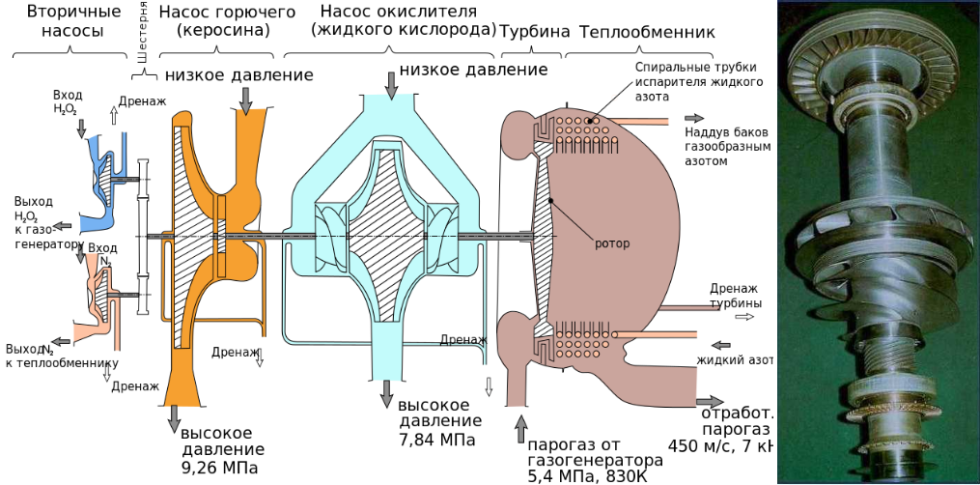
On the left - the diagram of the tha RD-107/108 for the R-7 family, on the right - the photo of the tha for the RD-180 (Atlas-V)
Turbopump unit operates in very harsh conditions. For example, the explosive destruction of TNA led to two accidents of the Soviet "lunar" H-1 rocket.
')
The combustion chamber
In the combustion chamber nozzles are located through which fuel and oxidant are injected. One of the main problems faced by engineers is the instability of combustion. Any accidental change in the flow through the nozzles can create a pressure surge that will cause components to detonate instead of burning even and cause problems until the engine fails. The only working solution turned out to be the separation of the combustion chamber into compartments isolated from each other by extended nozzles or partitions:

On the left - RD-107/108, in the center - RD-180, on the right - F-1 (the first stage of Saturn-V)
Nozzle
And here the main problem is heat dissipation. The temperature in the combustion chamber can reach 2000 degrees Celsius, and the heat flux density - 1-20 MW / m ^ 2, which is comparable to the annual energy from the Sun per m ^ 2 near the equator.
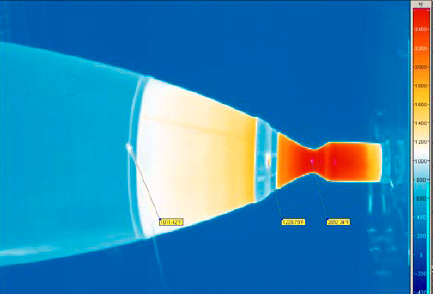
The most effective solution was the so-called. regenerative cooling. The fuel component (usually fuel) is pumped into the cooling jacket on the outside of the nozzle. To do this, in the United States came up with a system of tubes, and in the USSR - a corrugated spacer and milled ribs:
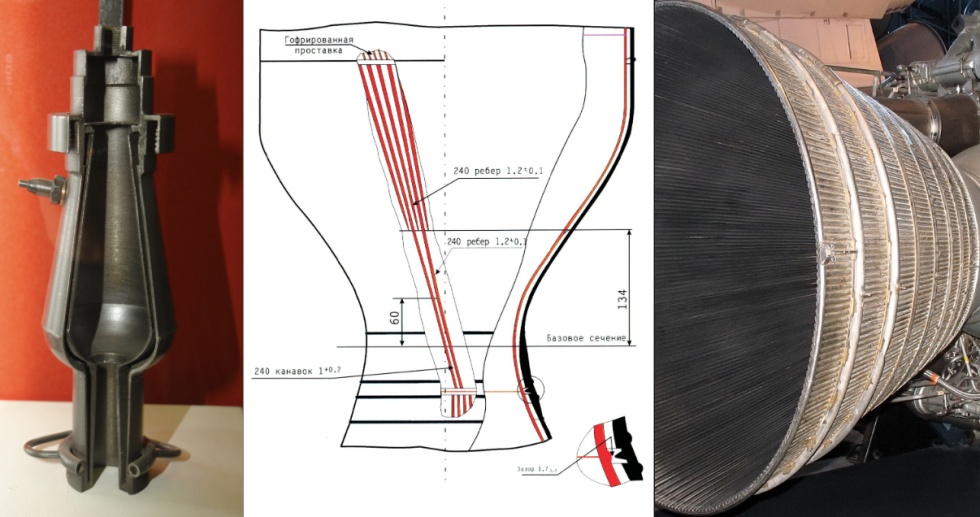
Left - RD-10, 1933, first experiments, centered - rib design on RD-107/108, right - LR-87, Titan-2
In addition, near the walls put nozzles that emit fuel, creating a curtain from the flame. There may be many such curtains (for example, there were four curtain belts on the V-2 engine). Here is an example of a curtain on an engine diagram - three curtain belts on the RD-170:

Efficiency
Talking about the efficiency of the engine as an integral parameter is virtually impossible. Because the engine and the stage at which it stands is a complex compromise of many parameters: technical complexity of creation / revision / production, cost of creation / revision / production, thrust, specific impulse, pressure in the combustion chamber, accumulated reliability and many others. And these parameters are in conflict with each other. A simple to manufacture and cheap, unloaded engine will have a mediocre thrust or specific impulse, and an engine with a very high specific impulse will be difficult, unreliable or too expensive. does not require investment in the development of a new one. For example, the Cosmos-2 rocket had to be fueled with six different liquids due to the fact that the first stage was a medium-range rocket, and the second stage was developed later and used other components of the fuel.
The situation is complicated by the fact that today the technologies are getting close to the physical limit of fuel efficiency, and the new engine will not be qualitatively better than the old ones based on well-known principles.
Control system
The control system solves two complex tasks: maintaining a stable flight and moving the payload to the required point in space.
Sustainable flight maintenance
Almost all launch vehicles are aerodynamically unstable in flight:
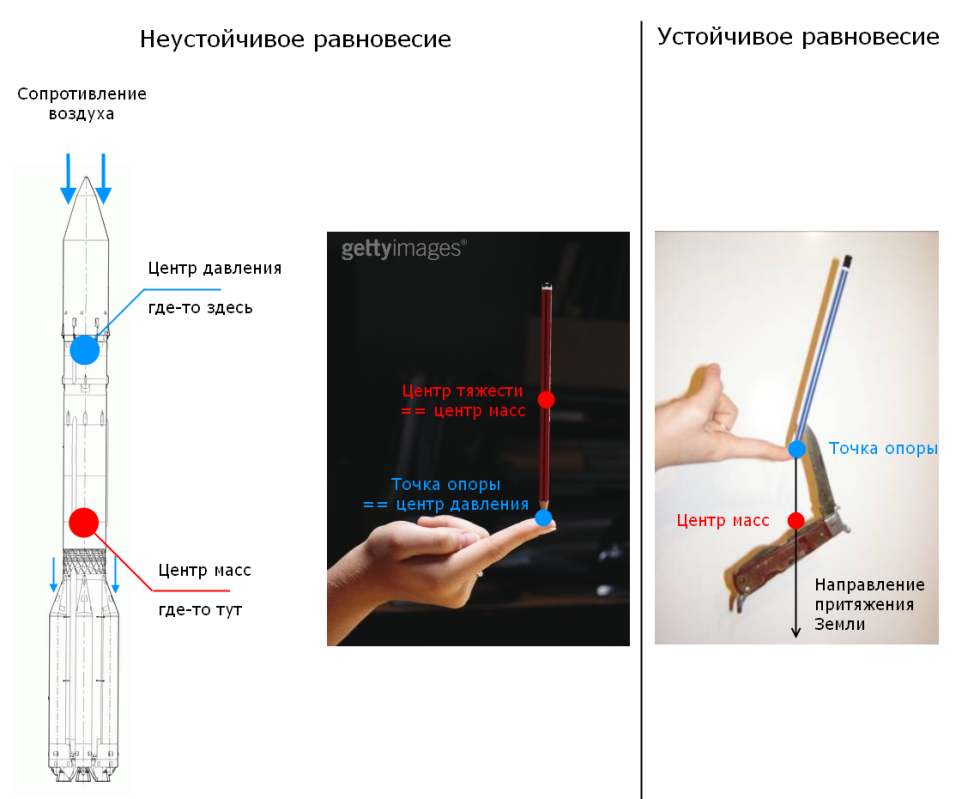
Another name for this problem is the “reverse pendulum”. And the control system maintains an unstable equilibrium, ensuring normal flight, fending off various disturbing influences.
Injection accuracy
Modern digital "Proton-M" has the following inaccuracy parameters :
- Perigee ± 2 km
- Apogee ± 4 km
- Inclination ± 1.8 ang. Min
- Removal time ± 3 s
If you have not played Orbiter or the Kerbal Space Program, it is very difficult to explain how high accuracy it is. Try to imagine that you are nine minutes away, closing your eyes, driving a car, and with an accuracy of ± 3 seconds you drive into a garage that is 8 centimeters longer than your car and 2 centimeters wider.
How does it work?
Why in the example with the machine from the previous paragraph, you had to close your eyes? Because there is no road marking in space, and modern systems do not use any external sources, but work autonomously. Inertial navigation system captures changes in the position of the rocket and acceleration that occur with it, producing control signals to the actuators. In the control system there is a so-called. a gyrostabilized platform on which position fixing gyroscopes are located, and accelerometers fixing accelerations. The platform itself is suspended so as to maintain its position:
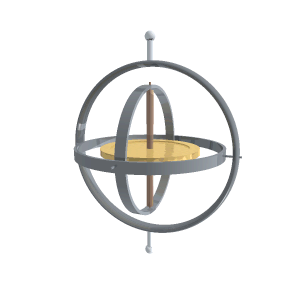
And they look like this:

On the left is the computer model of the platform that the center makes to them. Pilyugina , in the center of the platform of the Oka missile system , on the right - the platform of the American Peacekeeper ICBM on an air suspension
Now, thanks to the development of computers and technology based on new principles, gyro-stabilized platforms are gradually becoming a thing of the past. Traditional gyroscopes have almost been replaced by laser ones , and the rotating platforms are replaced by free-form systems, where gyroscopes and accelerometers are rigidly fixed to the body, and their data are processed by a computer. By the way, gyroscopes in consumer electronics are not rotating and not laser - they are vibratory . Accuracy is so-so, but small and cheap.
Reliability measures
In our imperfect world, not only a complex engine, but also a simple wire, a sensor or a valve, refuses to refuse. Therefore, special measures are taken:
- The actuators are duplicated whenever possible: when one element fails, a spare is triggered. The mission of the Space Shuttle STS-112 almost ended in a catastrophe at the start, when the main detonators of the pyrobolts that were holding the side solid propellant boosters failed. Fortunately, duplicate detonators worked, and the pyrobolts broke all and at the right time.
- Measuring instruments are triple: three sets of sensors are put, they “vote” and, in the event of a failure of one of the sensors, two “healthy” ones continue to give correct information. There was an accident in the aviation when two out of three gyro horizons failed, and the autopilot started the car at the peak. Fortunately, the pilots intervened, and disaster did not happen. With the proliferation of computers, a fourth “voice” is sometimes added (or a third instead of one of the sensors) —a mathematical model “as it should be.”
Conclusion
I hope you have become more familiar with the familiar and inconspicuous complexity of rocket technology, so that, after successfully removing the payload, you will be glad not only for it, but also for the rocket.
Source: https://habr.com/ru/post/208048/
All Articles